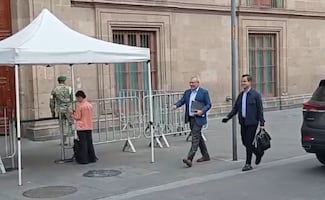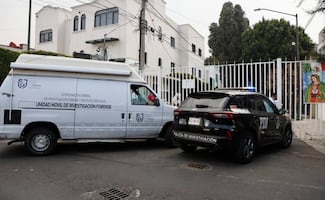Más Información

Senador del PT propone crear televisión, radio y periódico de la 4T; debemos hacer frente a medios de derecha, dice

César Duarte comparece ante jueza en penal del Altiplano; buscan vincularlo por presunto lavado de dinero

¿Qué es el Tratado de Aguas de 1944 entre México y EU por el que Trump amaga con imponer aranceles?; te explicamos

Gobernador de Michoacán se reúne con Sheinbaum en Palacio Nacional; acude también gabinete de Seguridad

Posponen en el Senado discusión y votación de reforma para crear la figura de “jueces sin rostro”; se discutirá en febrero

VIDEO Hallan a pareja sin vida en colonia Lindavista; una de las víctimas era abogado que litigó temas de despojos en Ecatepec
Osbelit García
is 14 years old and in recent months painted the collection of five hyperrealistic paintings called “The Hands of my Great-Grandmother,” “Garlic,” “Butterfly,” “Passion fruit,” and “Dad in the Field.”
Osbelit wants to portray through brushstrokes and paint the essence of her community Coaquimixco , in the Mexican state of Guerrero .
Part of her work has been displayed in c ity councils, art centers, and culture houses , as well as in public squares of different cities of her state.
“I paint because I love it and I want to transmit what we really are. Our culture is in the harvest and craftsmanship ,” said Osbelit in an interview with EL UNIVERSAL .
The first brushstrokes
When she was eight years old, Osbelit started to draw in her school notebooks the images that got stuck in her mind: Food, landscapes, objects, or her dad working in the fields . Soon, and without noticing, she filled whole notebooks with portraits of the people around her and the culture of her community.
Her canvases moved toward the genre known as “Costumbrismo,” a movement of Colonial times that portrayed the habits of Mexico and that was popularized by painter from Puebla Juan Cordero.
Osbelit started to paint by herself.
During recess, in her home’s kitchen, and a few times when being asked to do so by her schoolmates. “I noticed that I liked it, and that I’d rather paint than play,” asserts the young painter.
She started in art when she was in the fifth grade of elementary school . Back then, teacher Saúl Meza García , a doctor in Visual Arts , arrived in the community to teach a course called “ Painting and Engraving .”
Osbelit’s talent emerged from that moment: “ Her progress has been very fast and surprising . When I met her, I noticed that she had the skill, but it wasn’t developed. So, due to her high level and ability, we started working in a different way,” says the teacher.
At 11 years old, she was chosen by her school to paint a mural in honor of priest Mariano Matamoros . In those times, she already stood out for being able to recreate a picture in a canvas. Then, she learned the technique of dry pastel , with which she performed the most famous works of her production.
Currently, Osbelit is 14 years old, she is in the third year of middle school and has continued her classes with Saúl Meza. Every afternoon she walks 20 minutes to arrive at her old elementary school to continue practicing her skills.
“I’d like to study art,”
she says with excitement that contrasts with the seriousness of her voice. However, she knows that there are obstacles to her passion , such as the lack of resources to get the material and to enroll in a university in the future.
According to Mexico’s National Institute of Statistics and Geography (INEGI), in Guerrero, the average education of the population of 15 years old is the first year of middle school. In addition, 54 out of every 100 persons do not finish basic education.
Saúl Meza explained that in the state, teaching is limited to the basics: Spanish language and Maths . If children want to learn art, they would have to travel two hours by bus and spend approximately MXN $400 per day to get new tools, take classes, or look for a scholarship.
Saúl is part of the 43 Arts Group , a collective that was created in 2014 after the disappearance of the student teachers of Ayotzinapa . Currently, they help 60 children divided into two classes. Despite the donations they receive, it is not enough to cover the expenses of almost MXN $10 thousand they invest in the artistic education of the minors.
Painting among violence
“ We do not make protest paintings due to insecurity and fear. Guerrero is not the place for it because of the risk of disappearing, whether it is you or your family. The paintings are focused on the cultural, to what our people do, thinks, and feels,” describes the teacher.
Among the insecurity and violence in Guerrero, Osbelit’s paintings started to become visible in the social networks of the 43 Arts Group. The first exhibition of the collective were paintings with the faces of each of the missing students to demand justice through art and that were given to their parents.
“We paint to fight, live, teach, experiment, and promote art in our hurt society,”
is how the artists of the collective describe themselves. After their first exhibits, Saúl and his colleagues started with the workshops to promote art as an alternative for girls, boys, and teenagers, with the objective of giving the minors a space that allows them to express the way in which they perceive their communities beyond violence and insecurity .
“There are more people like me”
Until now, Osbelit has sold two of her five paintings , however, “Dad in the Field” is the only one she wants to keep to hang it in her living room. “He is my dad; he has supported me all the time,” she mentions.]
She adds that in her last exhibit, in Acapulco’s Cultural Center , two visitors asked her to paint for them a girl and a fruit bowl. The profits from those paintings, she said, will be used for her future travel expenses to other exhibits since her parents do not have formal jobs.
In previous years, the girl has been able to paint thanks to economic and material donations . People close to her assert that she needs a scholarship that guarantees her artistic education.
Osbelit hopes to receive enough support so that minors like her and her siblings, María and Juan David, can develop their talents , for she knows that a kid only needs someone for his or her art to be “an escape from the violence in which they live.”
Noticias según tus intereses
[Publicidad]
[Publicidad]













